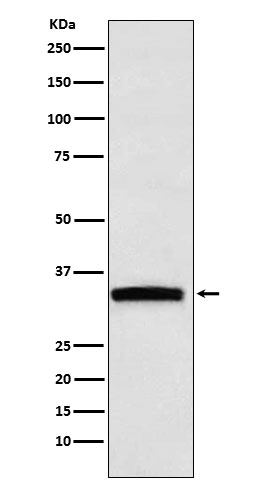
| WB | 1/1000-1/2000 | Human,Mouse,Rat |
| IF | 咨询技术 | Human,Mouse,Rat |
| IHC | 咨询技术 | Human,Mouse,Rat |
| ICC | 技术咨询 | Human,Mouse,Rat |
| FCM | 咨询技术 | Human,Mouse,Rat |
| Elisa | 咨询技术 | Human,Mouse,Rat |
| Aliases | GDF-15; growth differentiation factor 15; MIC-1; MIC1; NAG-1; PDF; PLAB; PTGFB;;GDF15 |
| WB Predicted band size | Calculated MW: 34 kDa ; Observed MW: 35 kDa |
| Host/Isotype | Rabbit IgG |
| Antibody Type | Primary antibody |
| Storage | Store at 4°C short term. Aliquot and store at -20°C long term. Avoid freeze/thaw cycles. |
| Species Reactivity | Human |
| Immunogen | A synthesized peptide derived from human GDF15 |
| Formulation | Purified antibody in PBS with 0.05% sodium azide,0.05% BSA and 50% glycerol. |
+ +
以下是关于GDF15抗体的3篇参考文献概览,涵盖其在不同疾病中的应用研究:
---
1. **文献名称**:*GDF15 neutralization restores muscle function and physical performance in a mouse model of cancer cachexia*
**作者**:Suriben R. et al.
**摘要**:该研究通过在小鼠癌症恶病质模型中注射抗GDF15单克隆抗体,发现其能显著逆转肌肉萎缩和功能下降,证明GDF15抗体可能成为癌症相关恶病质的潜在疗法。
---
2. **文献名称**:*Anti-GDF15 antibody improves metabolic dysfunction in obese mice by reducing food intake and glucose intolerance*
**作者**:Mullican S.E. et al.
**摘要**:研究显示,抑制GDF15信号通路可通过抗体中和GDF15.改善高脂饮食诱导的肥胖小鼠的血糖代谢异常,并降低食欲,提示其在代谢综合征治疗中的应用潜力。
---
3. **文献名称**:*GDF15 mediates the metabolic effects of PPARα by blocking hepatic mTORC1 signaling*
**作者**:Chrysovergis K. et al.
**摘要**:该文献发现GDF15抗体可逆转PPARα激动剂诱导的肝脏mTORC1通路抑制,揭示了GDF15在调节肝脏代谢中的关键作用,并验证了抗体在干预代谢异常中的效果。
---
这些研究展示了GDF15抗体在癌症恶病质、肥胖及代谢疾病中的治疗潜力。如需具体文献链接或补充更多研究,可进一步说明。
GDF15 (Growth Differentiation Factor 15), a member of the TGF-β superfamily, is a stress-responsive cytokine implicated in diverse physiological and pathological processes. It is weakly expressed under normal conditions but markedly upregulated during cellular stress, inflammation, metabolic disturbances, and diseases such as cancer, cardiovascular disorders, and obesity. GDF15 binds to the GDNF-family receptor α-like (GFRAL)-RET complex, primarily in the brainstem, to regulate appetite, energy homeostasis, and body weight. While its role in appetite suppression has sparked interest in treating obesity, persistently elevated GDF15 levels are linked to cachexia, chemotherapy resistance, and poor prognosis in chronic diseases.
GDF15-neutralizing antibodies have emerged as therapeutic tools to counteract its detrimental effects. In preclinical models, these antibodies mitigate cancer-associated cachexia, reverse muscle wasting, and improve survival. Conversely, agonist antibodies mimicking GDF15 activity are explored for obesity management. Challenges include balancing its dual roles—pathological vs. metabolic benefits—and minimizing off-target effects. Clinical trials are ongoing to evaluate safety and efficacy, particularly in cachexia and metabolic syndromes. However, the complexity of GDF15 signaling and tissue-specific responses necessitates further research to optimize therapeutic strategies. Overall, GDF15 antibodies represent a promising yet nuanced approach for modulating metabolic and wasting disorders.
×